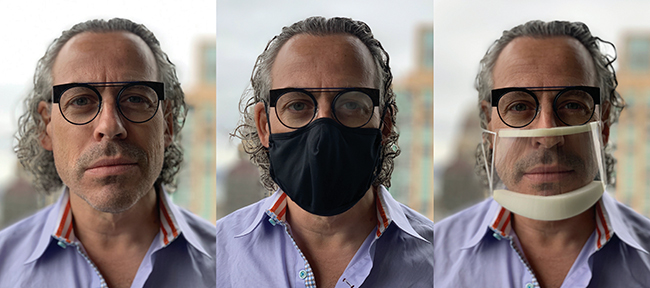
Overcoming the Mask
Tips for communicating through COVID-19
It can be challenging to communicate through masks, 6-feet of social distance, physical barriers and other factors due to COVID-19 that have changed daily life.
For people with hearing loss, this is an especially challenging time. In a telling sign of increased hearing difficulty, usage of online hearing tests increased 500% since the pandemic began.
“With COVID-19 and masks, everyday tasks are a source of frustration, such as asking a question at the grocery store deli or talking to someone from behind a customer service desk,” said Bill Schiffmiller, a lifelong hearing aid user and founder and CEO of Akoio, a hearing wellness company. “It’s a triple threat because masks reduce the loudness of the voice, muffle pronunciation and eliminate visuals like facial expressions and lip reading.”
Data shows people who can’t hear others begin to stay away from other people, and social isolation can lead to anxiety and depression. People who have trouble hearing also tend to have higher hospitalization rates and longer hospital stays, according to research published in “JAMA Otolaryngology.”
Among those 55 and older who have hearing loss, 58% don’t use hearing aids. In the past, statistics have shown people waiting up to seven years before getting a hearing aid from the time of diagnosis. However, the communication challenges posed during COVID-19 are driving some to address their hearing sooner than they may have otherwise.

Help Someone Hear You Better
- Consider the mask you\’re wearing. Clear masks provide a visual difference, helping with lip reading and facial expressions. The plastic in clear masks, however, can muffle sound too much for some. According to audiologist Dr. Shivani Patel, high-frequency hearing loss is common, making female voices difficult to hear. In this situation, research has found standard medical masks tend to transfer sound best. Try different masks to see what works for you.
- Minimize background noise. Music, construction, other conversations, heaters and fans can make it challenging to communicate when wearing a mask.
- Avoid “cavernous” rooms. An environment with mostly hard surfaces, such as a large meeting room or gymnasium, offers minimal sound dampening and can make hearing comprehension more difficult.
- Maintain eye contact. Look directly at the person you’re speaking to and speak clearly, helping him or her read some of your facial expressions. When using video conference services, look directly into the camera in a well-lit room and ensure you have clear picture quality to help with lip reading.
- Be patient. Remember the increased challenges people with hearing loss are facing now. If communication becomes too challenging through a mask, have a backup plan such as pen and paper or a smartphone note-taking app.
When You’re Having Trouble Hearing
- Talk to your friends and family. Tell them what you’re experiencing and be clear and direct in expressing your thoughts and feelings. Ask whether they have noticed your hearing troubles and listen to their feedback.
- Describe specific instances and circumstances when your hearing is affected most. Armed with this knowledge, friends and family can help you manage various situations.
- Determine a plan of action. Set an appointment to have your hearing checked by an audiologist. If you wear a hearing aid, be sure to carry extra batteries. Notice ways to adjust your environment to reduce background noise.
- Make hearing wellness a priority. Data shows hearing is important to a person’s mental and physical wellness, and untreated hearing loss can have multiple health consequences.
Find more hearing resources, downloadable guides and an audiologist finder at akoio.com.
Photo courtesy of Getty Images (friends talking)
Photo courtesy of Akoio (mask examples)
Source:
Akoio